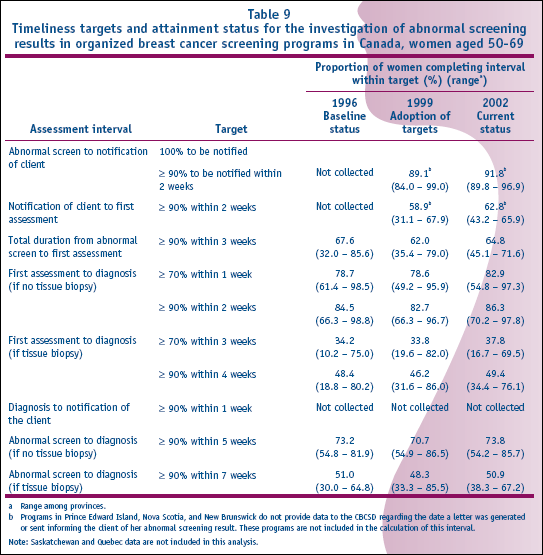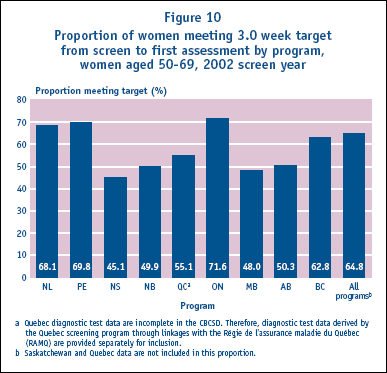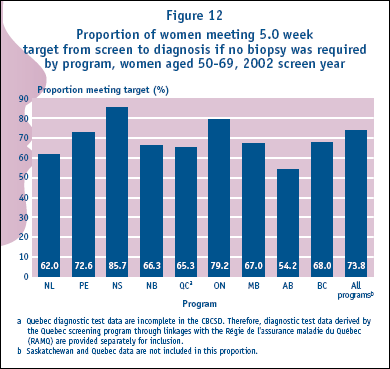Common menu bar links
Institutional links
Diseases & Conditions
Health & Safety
Research & Statistics
Agency Information
Search Box
E-mail this page
Organized Breast Cancer Screening Programs in Canada - Report on Program Performance in 2001 and 2002
Special Topic
Waiting for a Diagnosis Following an Abnormal Breast Screening Examination in Canada-Progress to Date
Efforts to achieve timely access to high-quality health care for all Canadians is a priority for governments, health providers and Canadians. Related concerns regarding delays during the assessment process and poor integration of screening and diagnosis were raised in April 1997 at a workshop on organized breast cancer screening. In response, the National Committee for the CBCSI established a Working Group on the Integration of Screening and Diagnosis. The mandate of the working group was to identify and assess the existing diagnostic processes after an abnormal breast screening examination for Canadian women and propose steps to achieve timely and seamless integration of screening and assessment for women with abnormal screening mammograms in Canada. On the basis of a review of the evidence regarding psychosocial and health implications and an analysis of the situation in Canada for 1996, the Working Group proposed timeliness targets that were subsequently adopted by the National Committee in 1999 (Table 9)16.

In spite of the challenge of a substantial increase in the volume of women undergoing diagnostic assessment, the overall national picture for diagnostic wait times improved slightly between 1999 and 2002. |
Programs sought to improve timeliness in the context of program expansion and growth. Since 1999 nearly all programs, most markedly in the new and expanding programs of Quebec and Ontario, experienced dramatic increases in the volume of women undergoing assessment. In spite of the challenge of a substantial increase in the volume of women undergoing assessment, from 14,837 in 1999 to 50,133 in 2002, the overall national picture for diagnostic wait times improved slightly during this period (Table 9). For each component of the diagnostic follow-up, the proportion of women who were assessed within target increased during the 4-year period between 1999 and 2002. However, only targets for the interval from abnormal screen to notification of the client and for the interval from first assessment to diagnosis (if no tissue biopsy was required) were met by any of the programs (Table 9). Nationally 90% of women were notified of results by 2.0 weeks following their screening examination in 2002 and all programs notified 90% of women close to, or well within the 2.0 week target. Similarly, in 7 of 8 programs that provided complete data to the CBCSD, at least 70% of women who did not require a biopsy were given a diagnosis within 1 week of their first assessment and in 3 of 8, at least 90% received a diagnosis within 2 weeks. In contrast, no program met targets for screen to first assessment (Figure 10), or screen to diagnosis (Figures 11 and 12). Achieving timely diagnosis is a particular challenge among women who require a tissue biopsy as part of their assessment process, leaving overall timeliness targets unmet (Figure 11).


Concrete guidance on what types of system changes would have an impact on waiting times has become available only more recently through the results of evaluated interventions initiated by organized Canadian screening programs. A number of pilots have implemented a redesign of the process. Some interventions have effectively reduced diagnostic waiting times, whereas others have not. For instance, a simple change involved a screening centre directly communicating abnormal findings to the diagnostic centre rather than advising the family physician to do so. This substantially reduced median time to diagnosis17. A similar process was implemented successfully in the Manitoba Breast Screening Program and resulted in significant reductions in the time to diagnosis after an abnormal screening result18. Since then, several other programs have instituted direct referral mechanisms.
In Nova Scotia, the screening program regularly navigates women through the diagnostic process on behalf of the family physician, a practice that has both provided supportive care to women undergoing assessment and has reduced waiting times19. With more evidence regarding which interventions have been most effective, jurisdictions will be better positioned to implement changes that are most likely to reduce diagnostic waiting times.
Overall, while there has been slight improvement toward meeting timeliness targets at the national level, more significant improvements are apparent in some provincial jurisdictions. Without broader dissemination, actions to improve waiting times taken at the regional level, are unlikely to impact on the overall national picture. In order to understand which interventions to improve waiting times are most effective, it will be important to continue to examine data at the regional level. This will be particularly important in identifying methods to improve timeliness for women undergoing tissue biopsy. Although dedicated assessment facilities associated with screening programs have been shown to effectively keep surgical waiting times lower, such facilities are often not a feasible option in settings other than larger urban centres. It appears that notification and other aspects of assessment within control of the program have, on the whole, improved. Better coordination of surgical assessment or increased capacity for the provision of core biopsy will be needed to improve waiting times for women who require a tissue biopsy to complete their diagnosis.

In September 2004, the Government of Canada and the First Ministers signed a historic, $41.3 billion, 10 year plan to strengthen health care. This includes $5.5 billion over 10 years to reduce wait times in five priority areas, including cancer. As a first step towards improving timely access to quality care, the First Ministers agreed in 2004 to establish evidence-based benchmarks for medically acceptable wait times in the five priority areas by December 31, 200520. The Government will also invest a further $500 million in medical equipment to enhance a prior $1.5 billion investment in 2003, for the Diagnostic/Medical Equipment Fund (D/MEF). The provinces and territories decide how to use the fund, which can be applied to the cost of purchasing, replacing/updating and installing mammography equipment. This investment will help to improve access to diagnostic care and treatment services and support training for specialized staff, key factors in reducing waiting times and sustaining a quality health care system.
Previous Page | Table of Contents | Next Page
